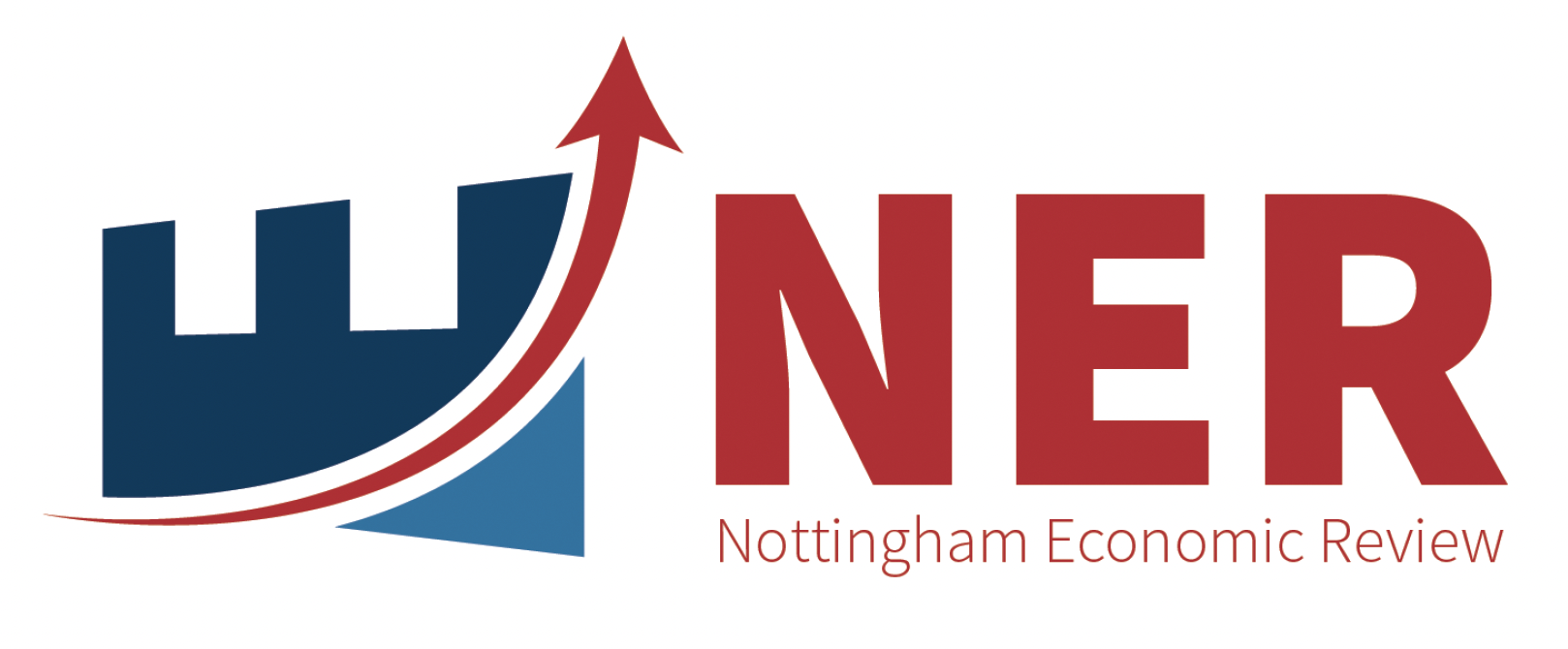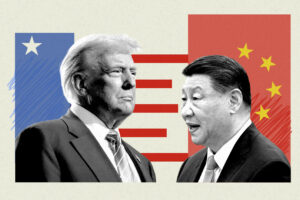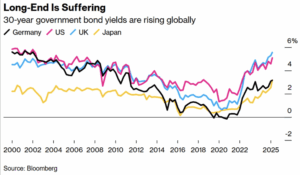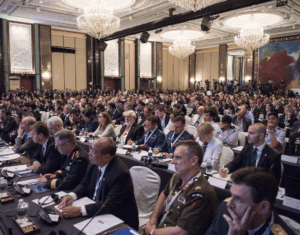A New Era of Economic Diplomacy?
Negotiations for the US-Ukraine resource deal in February 2025 marked the start of a new era of economic diplomacy. The unprecedented resource-for-aid agreement was first proposed by Kiev in September 2024. The US has since presented an ultimatum: take the deal or lose military aid. If ratified, it would give the US access to mining contracts, mineral deposits, oil, and gas reserves in Ukraineas compensation for the military and economic aid provided by the US (Aikman & Gregory, 2025).
The deal takes the form of a joint-managed “Reconstruction Investment Fund”, funded by 50% of all earnings from Ukrainian “natural resource assets” including mineral deposits, “hydrocarbons, and other extractable materials” (Financial Times, 2025). The Fund’s profits will be reinvested into Ukrainian infrastructure projects and the furthering of its interests. In return, the US “will maintain a long-term financial commitment to… Ukraine” (Financial Times, 2025).
Notably, the agreement makes no mention of how long the fund will be in place, or the total contribution requirements of the US, raising fears about the deal’s indefinite nature. Additionally, it lacks security guarantees, a key demand from Kiev in negotiations (Baskaran & Schwartz, 2025b). At the time of writing, the deal remains unfinalised, and the US has withdrawn military aid. However, regardless of its final status, the motivations and broader implications of this resource-for-aid agreement remain critical.
Why this Deal has Changed the Game
There is little precedent for such a resource-for-aid deal, especially between two allied states. Historically, foreign aid has been given freely, as a grant, and controlled by the relevant states. It may have political strings attached, but rarely involves financial repayment unless otherwise stipulated. For instance, the US provided over $500 million in aid to South Korea during and after the Korean war (1950-53) without expecting financial repayments (Lee & Lee, 2025).
This deal signifies a fundamental shift in US economic diplomacy – moving from aid as a grant to aid as a transactional and financialised agreement. It leans on the principles of dependency theory, which suggests that wealthier nations leverage financial and resource dependencies to exert influence over less powerful states. In this case, by leveraging Ukraine’s geopolitical vulnerability to secure long-term control over its natural wealth, the US reaffirms the dictate of economic dependency.
The Biden administration originally framed military aid to Ukraine as a grant, emphasising its role as a component in defending democracy. However, under Trump’s presidency, it has been repackaged as a conditional loan – one that requires mineral compensation. Trump’s February 28th Oval Office exchange with Zelensky made it explicit that Ukraine “do not have the cards” to protest (The Telegraph, 2025).
The deal is representative of a new globalised age of conflict management. In a world dominated by Global Supply Chains (GSCs), access to certain minerals and rare earth metals grants far-reaching control of production: batteries, electric cars, weapons, laptops. GSCs mean that production is highly international and interdependent. An iPhone, for example, is designed in California, manufactured in China, with materials mined in Africa and Europe, packaged in the US, and shipped worldwide. (Cheng, 2015)
At the heart of GSCs is the dominance of privately owned corporations. By providing the mining infrastructure and extraction expertise at lower costs, it is these corporations that reap the benefits, not government bodies. The success of the deal is thus largely dependent on generating enough private investment from US companies and other TNCs to exploit the opportunities provided. But with ongoing security risks, damaged infrastructure networks, and unreliable mapping data (Baskaran & Schwartz, 2025a), firms may be reluctant to bring the investment needed for either party to profit. Security and diplomacy are increasingly in the hands of private companies, not elected governments.
Washington’s Motivations
At the heart of this deal lies America’s urgent need for mineral security. The US remains highly dependent on China, which controls 75% of the world’s rare earth metal supply. However, amid escalating tensions in the Sino-American trade war, Beijing imposed significant export restrictions on these metals and other critical minerals in December 2024 (Baskaran & Schwartz, 2024). This move threatened key American industries, with these natural materials being used domestically in “healthcare, transportation, and power generation”(OFECM), as well as being positioned internationally as “the foundation of the 21st century economy” (Muggah, in Abdurasulov & Plummer, 2025).
With supply chains disrupted and China tightening its trade policies, Washington is scrambling to fill the supply gap. Ukraine, with its vast mineral and economic vulnerabilities presents a strategic leverage point. The country is home to 19 million tonnes of graphite, alongside large supplies of titanium, lithium, and rare earth metals (Abdurasulov & Plummer, 2025). The US has justified its access to these reserves by claiming that without its infrastructure investment, these deposits would remain untapped. The plan envisions US-led investment in mines, separation plants, and the surrounding transport networks required to exploit the vast mineral deposits and establish a supply chain independent of China.
However, sceptics question the economic viability of this strategy, considering the deal largely tokenistic. Even without the damaged infrastructure, mining operations can take 10-20 years to reach full operational capacity(Baskaran & Schwartz, 2025a). Given the ongoing conflict and security concerns, it could be decades before any meaningful economic value is extracted from these assets. Given Trump’s use of tariffs as bargaining chips for more favourable terms, critics see this agreement in a similar light as a tool to reshape political optics rather than drive concrete economic benefits.
Carl Bildt, former Swedish Prime Minister, suggests the deal is crafted to appeal to Trump’s political instincts. Trump thrives on power plays and the perception of dominance – all of which this agreement encapsulates. The resource-for-aid deal allows Trump to reframe foreign aid as a business transaction, reinforcing his “America First” economic nationalism.
Yet, beyond personal politics, the move also serves a broader strategic function. By entrenching Ukrainian dependency to the US, Trump gains a critical geopolitical pawn in Europe. Given the economic problems at home, this allows him to dispel domestic discontent regarding the billions poured into foreign policy by presenting them as an investment rather than outright expenditure.
A Warning from History?
The long-term implications of this deal for Ukraine are uncertain. While some view the deal as necessary for Ukrainian survival, others warn of an emerging neo-colonial dynamic. Comparisons have been drawn to China’s resource-for-infrastructure model, particularly the Sino-Congolese Des Mines agreement in 2007(Baskaran & Schwartz, 2025a).
In that case, China committed vast infrastructure development in return for mining access to cobalt, copper, and other minerals. However, the agreement lacked transparency and “never included any guarantee of the actual value that the Congolese population would get” in return (Larrarte & Claudio-Quiroga, 2019). Today, despite the immense wealth the Congo possesses, it remains one of the poorest nations in the world – a stark reminder of the risks when resource-rich but politically vulnerable nations cede too much control to foreign powers.
While exact parallels cannot be drawn, the underlying risks are strikingly similar. The deal is only on the table because Ukraine is weakened by war and financially strained. Even in this vulnerable position, Kiev has negotiated fiercely, with Zelensky firmly declaring that Ukraine’s freedom is “not for sale” (Kuenssberg, 2025). However, history shows that economic entanglements – especially those factoring in critical resources – bear long-term consequences outlasting initial agreements.
By attempting such an unprecedented deal, America has signalled a seismic shift in how modern aid diplomacy is conducted. The question now is whether this model will spread. Ukraine, and its European allies, will be watching closely, wary that future military and economic assistance may come with strings attached. If this agreement sets a precedent, it could redefine the nature of foreign aid, turning it into a transactional agreement where concessions are mandatory.
For Ukraine, the stakes are existential – but the broader implications of this deal extend far beyond Kiev.
Bibliography:
Abdurasulov, A & Plummer, R (2025, 26 Feb). ‘What minerals does Ukraine have and what are they used for?’ BBC News, Business. Retrieved from: https://www.bbc.co.uk/news/articles/c20le8jn282o
Aikman, I & Gregory, J. (2025, Feb 26). ‘What we know about US-Ukraine minerals deal’. BBC News, World. Retrieved from: https://www.bbc.co.uk/news/articles/cn527pz54neo
Baskaran, G & Schwartz, M. (2024, 4 Dec). ‘China Imposes Its Most Stringent Critical Minerals Export Restrictions Yet Amidst Escalating U.S.-China Tech War’.Centre for Strategic and International Studies. Retrieved from: https://www.csis.org/analysis/china-imposes-its-most-stringent-critical-minerals-export-restrictions-yet-amidst
Baskaran, G & Schwartz, M. (2025a, 21 Feb). ‘Assessing the Viability of a U.S.-Ukraine Minerals Deal’ Centre for Strategic and International Studies. Retrieved from: https://www.csis.org/analysis/assessing-viability-us-ukraine-minerals-deal
Baskaran, G & Schwartz, M. (2025b, 27 Feb). ‘Breaking Down the U.S.-Ukraine Minerals Deal’. Centre for Strategic and International Studies. Retrieved from: https://www.csis.org/analysis/breaking-down-us-ukraine-minerals-deal
Bildt, C. [@carlbildt]. (2025, 26 Feb). “Carl Bildt told BBC News the mineral deal seems like a “sideshow” and mostly designed to “keep Mr. Trump happy.” “But it is not going to give a lot of money to the U.S., and I don’t see it having any materially economic effect for very many years.” [Post]. X. Retrieved from: https://x.com/carlbildt/status/1894849103634272440
Cheng, L. (2015) ‘Making of the iPhone’. The Ohio State University. Retrieved from: https://u.osu.edu/iphone/
Financial Times. (2025, 26Feb) ‘US-Ukraine Minerals Deal: The Full Text’ Financial Times, War in Ukraine. Retrieved from: https://www.ft.com/content/387afd63-9467-413f-84d0-4f52a3a95a34
Kuenssberg, L. (2025, 3 Mar). ‘Zelensky bruised but determined after diplomatic whirlwind’. BBC News, World. Retrieved from: https://www.bbc.co.uk/news/articles/c0rz178el8go
Larrarte, A & Claudio-Quiroga, G. (2019, 3 Apr) ‘The DRC and China’s Sicomines: why future deals should be different’. The Conversation, Business and Economy. Retrieved from: https://theconversation.com/the-drc-and-chinas-sicomines-why-future-deals-should-be-different-114571
Lee, K & Lee, JH. (2025). ‘Armistice and aid in Korea’. Britannica. Retrieved from: https://www.britannica.com/place/Korea/Armistice-and-aid
Office of Fossil Energy and Carbon Management. (n.d.) ‘Rare Earth Elements’. U.S. Department of Energy. Retrieved from: https://www.energy.gov/fecm/rare-earth-elements#:~:text=Many%20advanced%20technologies%20have%20components,petroleum%20refining%2C%20and%20consumer%20electronics.
The Telegraph. (2025, 28 Feb). ‘Full argument: Trump-Zelensky White House meeting descends into shouting match’ [Video] YouTube.com. Retrieved from: https://www.youtube.com/watch?v=v_kTNIYsFnQ




